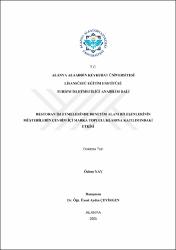Restoran işletmelerinde deneyim alanı bileşenlerinin müşterilerin çevrim içi marka topluluklarına katılımındaki etkisi
Özet
Bu çalışmanın temel amacı restoran işletmelerinde deneyim alanı bileşenlerinin müşterilerin bu restoranların sosyal medya platformlarındaki marka topluluklarına katılımı üzerindeki etkilerini ortaya koymaktır. Bunun yanı sıra restoran müşterilerinin deneyim alanı bileşenlerinin ve bu restoranların internet marka sayfalarına katılım (yorum, video, fotoğraf vb.) nedenlerinin belirlenmesi amaçlanmaktadır. Diğer taraftan katılımcıların profiline göre deneyim alanı bileşenleri ve çevirim içi marka topluluklarına katılımına yönelik görüşlerinde anlamlı bir farklılık olup olmadığı çalışma kapsamında incelenmiştir. Araştırmada nicel araştırma yönteminden yararlanılmıştır. Çalışmanın evrenini, alakart restoranlarda deneyimi bulunan ve daha sonra restoran deneyimini sosyal medya platformları aracılığıyla restoranların internet sayfalarında paylaşan kişiler oluşturmaktadır. Çalışmada amaçlı örneklem yöntemlerden ölçüt örnekleme ve kartopu örnekleme yöntemleri kullanılmıştır. Çalışma konusunun sosyal medya platformlarıyla ilgili olması ve COVID-19 Pandemisi nedeniyle veriler çevrim içi anket yöntemiyle toplanmıştır. Pilot çalışmada geçerlik ve güvenilirlikleri analiz edildikten sonra 22.12.2020 - 08.03.2021 tarihleri arasında toplamda 423 çevrim içi anket toplanmıştır. Elde edilen verilere faktör analizi, korelasyon, çoklu regresyon analizi ve farklılık testleri uygulanmıştır. Restoran işletmelerinde deneyim alanı bileşenleri; duyusal, fonksiyonel, doğal, kültürel ve ağırlama kültürü bileşeni olmak üzere beş boyuttan oluşmaktadır. Aynı şekilde müşteri katılımının boyutları için de heyecan, etkileşim, kimlik, bilgi, memnuniyet ve tavsiyeden oluşan beş boyut elde edilmiştir. Farklılık analizinde elde edilen sonuçlara göre cinsiyet, yaş, eğitim durumu, aylık restorana gitme sıklığı ve restoran çeşitlerine göre deneyim alanı bileşenlerinde anlamlı bir farklılık olduğu saptanmıştır. Cinsiyet, yaş ve eğitim durumuna göre müşteri katılımı boyutlarında anlamlı bir farklılık olduğu bulunmuştur. Elde edilen sonuçlara göre deneyim alanı bileşenleri ile müşteri katılımı arasında ilişki olduğu belirlenmiştir. Fonksiyonel, doğal, kültürel ve ağırlama kültürü bileşenlerinin müşteri katılımı üzerinde anlamlı ve olumlu etkiye sahipken duyusal bileşenin anlamlı bir etkisi bulunmamaktadır. Müşteri katılımı üzerinde en çok ağırlama kültürü bileşeni etkili iken doğal bileşenin ise en az etkiye sahip olduğu sonucuna varılmıştır. The main purpose of this study is to reveal the effects of experienscape components in restaurant businesses on customers engagement in the brand communities of these restaurants on social media platforms. In addition, it is aimed to determine the components of the experienscape of restaurant customers and the reasons for engagement in the internet brand pages of these restaurants (comments, videos, photos etc.). On the other hand, it was examined within the scope of the study whether there is a significant difference in views on experienscape components and customer engagement in online brand communities according to participants' profile. The quantitative research method was used in the research. The population of the study consists of people who have experience in à la carte restaurants and then share their restaurant experience on the internet pages of restaurants through social media platforms. Criterion sampling and snowball sampling methods, which are among the purposeful sampling methods, were used in the study. Due to the fact that the subject of the study is related to social media platforms and the COVID-19 Pandemic, the data were collected by online survey method. After analyzing the validity and reliability of the pilot study, a total of 423 online questionnaires were collected between the dates of 22.12.2020 and 08.03.2021. Factor analysis, correlation, multiple regression analysis and difference tests were applied to the obtained data. Components of the experienscape in restaurant businesses consists of five dimensions: sensory, functional, natural, cultural and hospitality culture. Likewise, for the dimensions of customer engagement are obtained from five dimensions consisting of enthusiasm, interaction, identification, information, satisfaction and a recommendation. According to the results obtained in the difference tests, it has been determined that there is a significant difference in the experienscape components according to gender, age, education level, monthly frequency of going to restaurants and restaurant types. It has been found that there is a significant difference in customer engagement dimensions according to gender, age and education level. According to the results obtained, it has been determined that there is a relationship between experienscape components and customer engagement. While the functional, natural, cultural and hospitality culture components have a significant and positive effect on customer engagement, the sensory component has no significant effect. It was concluded that while the hospitality culture component was the most effective on customer engagement, the natural component had the least effect.
Koleksiyonlar
- Tez Koleksiyonu [253]


















